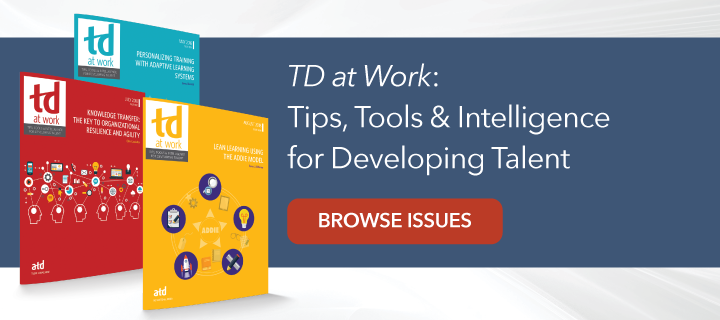According to the ATD whitepaper Bridging the Skills Gap: Workforce Development and the Future of Work, 83 percent of respondents believed their organization had a skills gap. Reasons for this difference between organizations’ capabilities and potential achievements in the workplace included that the skills of the current workforce do not match changes in company strategy, goals, markets, or business models and the lack of requisite skills when promoting internal candidates.
Skills You Have, Skills You Need
If you’re a talent development professional, how can you help change this? “Employers must consider a variety of factors to understand which skills matter not just today or tomorrow but months or even years from now,” Ben Eubanks wrote in “ Meeting Tomorrow’s Skills Demands Today.” He explained that identifying those skills should start with tracking the skills that exist within your organization. Employees should self-report their capabilities, which then can be affirmed by manager observations, peer feedback, and assessments.Noting employees’ skills will help the talent development professional understand who could be strong candidates for upskilling (that is, developing additional skills to help an individual become even more valuable in their current role) and who would be better suited for reskilling opportunities (that is, developing significantly different skills to help them fit into a new role).
Consider:
- What skills and jobs within your organization are most likely to be affected by disruption and automation?
- How quickly do you expect that to happen?
- What skills will you need to teach?
- By what methods?
- What will success look like?
Strategically Selling Development of New Skills
How TD professionals sell their vision to upskill and reskill staff significantly influences its success. They need to communicate the importance of such an initiative and keep in mind the “what’s in it for me” for each audience member.
Leaders, for example, should convey the cost-effectiveness of developing current employees compared with hiring new talent. “Work with sales and operations leaders to identify the skills needed to deliver on the kinds of services or products customers are asking for,” recommends Eubanks. TD professionals should also talk with marketing staff about how to appropriately craft their message—for example, by creating a video of an employee who can be the face of the development initiative.
Topics for discussion and points include:
- Executives. Bring executives the numbers and raw facts. Consider what you have identified as gaps in your organization compared with other places in the market. How short are you on being able to deliver what your business needs to deliver to be a success?
- HR leaders. How many employees leave the organization because of lack of skill development? That can be among the topics of conversation you have with HR leaders. Checking employee engagement surveys may help uncover answers. Use that information to estimate how much money a strategic upskilling program may save the organization.
- Managers. Managers are interested in team stability and performance. Work with them to understand how much they know about team members’ skills and where they fall short. Share the challenge with managers and let them share in the solution to have a stake in the outcome.
- Employees. Yearning for growth opportunities and job stability, employees often will be eager to discuss insights into the market and what skills gaps they see in themselves and in the workforce.
The jobs of the future are likely to become more human in design, more service-oriented, and more reliant on soft skills. We also know that routine tasks, either mental or physical, are more likely to become automated. This information, along with critical study of industry and conversations with internal stakeholders, will help a TD professionals create, as Eubanks wrote, a “broad game plan for how to address a skills gap within an organization.”




